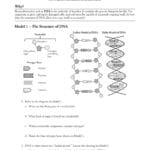Want to understand how traits are passed down from one generation to the next? Punnett squares are your key to unlocking the secrets of inheritance! This guide provides a comprehensive overview of Punnett squares, from basic principles to advanced applications, and offers practical advice on how to use worksheets effectively to solidify your understanding.
Understanding Punnett Squares
Punnett squares are a powerful visual tool used to predict the probability of offspring inheriting specific traits. Think of them as a genetic crystal ball, providing insights into how genes, the blueprints of life, are passed from parents to their children. These squares take the form of a grid, with each side representing the possible gene versions (called alleles) that a parent can contribute. The boxes within the grid show the potential combinations of these alleles in the offspring, revealing the likelihood of different traits appearing.
[https://www.lolaapp.com/punnett-square-worksheet]
Mendelian Inheritance: The Foundation
At the heart of Punnett squares lies Mendelian inheritance, named after Gregor Mendel, the father of genetics. Here are the key principles:
- Genes: Segments of DNA that code for specific traits.
- Alleles: Different versions of a gene (e.g., one for brown eyes and one for blue eyes).
- Dominant Alleles: The “stronger” version of a gene, often represented by a capital letter (e.g., “B” for brown eyes). If present, the dominant trait will be expressed.
- Recessive Alleles: The “weaker” version of a gene, represented by a lowercase letter (e.g., “b” for blue eyes). A recessive trait is expressed only when two recessive alleles are present.
- Genotype: The genetic makeup of an organism, represented by letters (e.g., BB, Bb, bb).
- Phenotype: The observable physical characteristic resulting from the genotype (e.g., brown eyes, blue eyes).
- Homozygous: Having two identical alleles for a gene (e.g., BB or bb).
- Heterozygous: Having two different alleles for a gene (e.g., Bb).
Why Practice with Worksheets?
While explanations can lay the groundwork, practice is essential for true mastery. Punnett square worksheets provide the perfect training ground, offering numerous benefits:
- Reinforcement of Concepts: Worksheets solidify understanding of Mendelian inheritance and the logic behind Punnett squares.
- Diverse Scenarios: They expose you to a wider range of genetic situations than typical textbook examples, from simple single-trait crosses to complex scenarios involving multiple genes and sex-linked traits.
- Application and Problem-Solving: Worksheets challenge you to apply your knowledge to practical problems, enhancing critical thinking and problem-solving skills.
- Self-Assessment: Worksheets with answer keys provide immediate feedback, allowing you to gauge your understanding, identify areas for improvement, and learn from your mistakes.
Types of Punnett Square Problems
Punnett squares accommodate various levels of complexity, mirroring the intricacies of genetics itself.
Monohybrid Crosses: One Trait at a Time
These focus on the inheritance of a single trait, such as flower color in pea plants. They typically involve a 2×2 grid and are ideal for beginners.
Dihybrid Crosses: Two Traits, Double the Challenge
Dihybrid crosses analyze the inheritance of two traits simultaneously, expanding the Punnett square to a 4×4 grid. This introduces the concept of independent assortment, where genes for different traits are inherited independently.
Sex-Linked Traits: X and Y Chromosomes
Sex-linked traits are carried on the sex chromosomes (X and Y). These worksheets explore how inheritance patterns differ between males and females, adding another layer of complexity.
Utilizing Worksheets Effectively
To maximize your learning with Punnett square worksheets, consider these strategies:
- Start with the Basics: Ensure a firm grasp of Mendelian inheritance before diving into complex problems.
- Progress Gradually: Begin with monohybrid crosses, then move on to dihybrid and sex-linked crosses as your understanding deepens.
- Visualize: Use different colors or symbols to represent alleles in your Punnett squares, making the combinations clearer.
- Hands-on Activities: Supplement worksheets with hands-on activities, like creating allele cards or using manipulatives to simulate crosses. This can enhance understanding and engagement.
- Check Your Work: Answer keys are not just for grading; use them to understand the why behind the answers, identify misconceptions, and guide your learning.
- Explore Different Resources: There is a wealth of free and paid worksheets available online. Explore different sources to find materials that suit your learning style and needs.
Finding the Right Worksheets
Worksheets cater to different learning levels, from basic to advanced.
- Basic Worksheets: Ideal for beginners, these focus on simple monohybrid crosses with dominant and recessive alleles.
- Intermediate Worksheets: Introduce more complex scenarios, such as dihybrid crosses, incomplete dominance (where traits blend), and codominance (where both alleles are expressed).
- Advanced Worksheets: Delve into sex-linked traits, pedigree analysis (tracing traits through family trees), and other advanced genetic concepts.
Free printable worksheets can be found on various websites, while paid resources often offer more comprehensive content aligned with specific curricula. [https://www.lolaapp.com/pedigree-worksheet]
Beyond the Square: The Bigger Picture
While Punnett squares are invaluable tools, it’s crucial to acknowledge their limitations. They predict probabilities, not certainties. Real-life genetics is influenced by a multitude of factors, including environmental influences, multiple genes interacting, and epigenetics (changes in gene expression without changes to the DNA sequence). Ongoing research continues to unravel these complexities, suggesting that our understanding of inheritance is likely to evolve further. Some experts believe that future models may move beyond Punnett squares to incorporate these multifaceted influences.
By combining a solid understanding of Mendelian principles with targeted practice using worksheets, you can master the art of Punnett squares and unlock a deeper understanding of the fascinating world of genetics. Remember, the journey of genetic discovery is ongoing, and Punnett squares are just the beginning!
















